Spinner'd Minners
By Fox Statler, Salem, AR
Some of the best information on fly fishing
is not found in books and magazines about fly
fishing. The majority of money and effort
spent on research of lure colors, materials,
habitat, fish behavior, fish diet, and so on
is coming from the bass, steelhead, and
walleye portion of the fishing industry.
These factions have and are devoting lots
of big bucks to learn more about catching,
raising, finding, and maintaining their
chosen species. Why not from fly fishers?
About 60% of all anglers own a fly rod but
less than 1% are hardcore addicts, so the
numbers of fly fishers is significantly less
than other angling methods. What is the
salvation for fly fishers? The best thing
we can do is to adapt the knowledge discovered
in other methods of the fishing industry to our
sport. I often spend my time reading books,
magazines, and research materials on the latest
methods, tactics, and lures on bass and walleye.
Simply thumbing through a lure catalog is a good
way to search for new patterns and materials.
The best book that I have read lately is, What
Fish See written by Dr. Colin J. Kageyama,
an eye doctor and avid steelhead fisherman. The
book explains how the impurities in water and the
properties of water effect what the fish see. It
also addresses why fish strike a lure and various
myths associated with the vision of fish and the
wives-tales of anglers. An informative in depth
discussion on why lure colors can experience
dramatic changes at depths of less than two feet
because of conditions such as light, temperature,
wind, water color, background color, silt, debris,
vegetation and other impurities found in water is
the most informative reading I have found in years.
I have learned that certain colors are filtered out
even in clear water. In the entire book only two
pictures (the last two) are of flies but these
two pictures were enough to convince me that hair,
fur, and feathers are the poorest of materials used
in fly tying. The book also discusses how noises
and vibrations can attract more fish to your pattern.
I purchased a "See Best" test kit that was offered
in the book to find out what my patterns look like
in the various colors of water and over different
colored backgrounds.
Synthetic materials, rattles, brightly painted
or colored beads and SPINNERS are our best bets.
That's right, SPINNERS. You say spinners are
not traditional and haven't been around very
long. We could say the same thing about
graphite rods, large arbor reels, Fluorocarbon
leaders, Epoxy head patterns...and so on. The
truly traditional approach of fly fishing is
an extremely long rod (13-17 foot long) with
only a tiptop guide, no reel, a fly line of
braided silk tied to the butt of your rod, a
cat-gut leader, and the proper attire might be
that worn by a nun. Now, how many of you are
"Traditionalists?" I am sorry but I will not
let some imaginary concept limit my approach
to fly fishing. Everyone wants to excel in
this sport but at the same time we let
traditionalists place restrictions on our
tactics, methods, and ideas. Fly fishers
often refer to Fox Statler as "out of the box."
The truth is that I never got in the proverbial
"box." I always assumed that fly fishing was
a sport that allowed imagination, creation,
adaptation, investigation, dedication, education,
revelation� and so many more "ations" and had
no limits. I have not let the traditionalists
restrict or pollute my approach to fly fishing.
In fact, my greatest joy is to catch more fish
than a traditionalist in the same water. Indicator
fly fishing is mentioned in The Compleat
Angler but it is not traditional. Let
me get off my "soap box" and back to spinners.
The idea of adding rattles to flies is new, but
the use of spinner blades is not. Unknown to
most fly fishers, the first spinner for fly
fishing was created about 1890 by Hildebrandt.
He hammered it out of a dime for his fly rod.
The idea was so successful that the company,
Hildebrandt Spinners, was created and is still
in existence today. Pistol Pete's flies are
quite popular out west and quite successful also.
These patterns incorporate a small propeller
just behind the eye of the hook. Most of the
Pistol Pete patterns resemble a Wooly Bugger
or 56'er. I can remember trying to create
Spinner'd Minners twenty years ago. The problem
was the beads. Beads that had the same size of
opening on each end of the hole could not be
forced around the hook-bend. The beads of
today solve that problem and Spinner'd Minners
are a reality. Even better than the beads are
the large bass tapered fly lines available.
Rio's Clouser Line and others can cast a key
chain and spinner'd flies are handled just as
easily as a large popping bug.
Do Spinner'd Minners catch fish? Well, do moles
walk funny? Do worms have short legs? Yes they
catch fish--lots of fish! Trout, Walleye, Sunfish,
Bass and Red Fish so far, but no catfish yet however,
I am hopeful.
Spinner'd Minners are easy to tie and with a
little knowledge of the basics about making
spinners you will be well on your way to
creating some of the most beautiful and
productive patterns ever tied at your vise.

Tying Instructions: Spinner'd Minners
1. Use a small wire hook. The smaller
the wire the better the spinner will spin
(less drag and friction). Several brands
and models of hooks are acceptable. Eagle
Claw 214 Aberdeen hook in sizes #1/0-#1
and Mustad #36620 in sizes #1/0-#1 are my
best so far. You can buy these hooks at
bait shops, fly shops, department stores
and grocery stores pretty cheap--about $5
per hundred. Shown is a #1 Eagle Claw 214
Aberdeen. De-barb the hook before beginning.

2. Place a #1 or #2 sized In-line Spinner
Blade on the hook I use a #1 hook with a #1
spinner and a #1/0 hook with a #2 spinner
but this is not mandatory for the performance
of the streamer. As of yet, I haven't found
In-Line Blades in smaller sizes. In-Line
Spinner Blades are lighter and spin better
at slower retrieval speeds than other types
of blades. Most clevis�n-blade setups (French,
Colorado, Indiana, and Willow Leaf blades)
are heavier and require a faster retrieval
rate to make them spin effectively. However,
they do work great in very fast water but
work the angler to death in slow water.
The best selection of In-Line Blades I have
found is online from Stamina Incorporated.
This link, https://www.staminainc.com, has a
great selection of In-Line Blades in various
colors and finishes.


3. Place a 5/32nd or 3/16th bead behind the
In-Line Blade regardless of the size of hook
or spinner used. The bead is needed to make
the spinner spin. Both suggested bead sizes
work equally well. Beads smaller than 5/32"
let the In-Line Blade lay back at an angel
that allows it to come in contact with the
back material of the streamer, thus the blade
spins poorly. Beads that are larger than 3/16"
hamper the performance of the In-Line Blade
by creating too much friction and spin too slow.

4. Start the thread at the bend of the
hook and tie in the tail portion of the
pattern. I prefer to use red to orange
thread in all of my streamers for warm
to cool water patterns. Red is the color
that the Sunfish family sees best due the
chemicals in their eyes (black bass are
sunfish). When tying in the different
parts of the streamer I always put a
couple wraps in the middle of the material
to position it, then double it back over
these wraps and finish wrapping the material
down. By tying the material in using this
"doubling back" technique it increases the
durability of the streamer by holding the
material more securely without using a lot
of glue. The finished length of the tail
has no effect on the performance of the
streamer so a tail of one to three hook-shanks
long is at the discretion of the tyer. Cut
your material two to six hook-shanks long
and tie it in using the doubling back method.
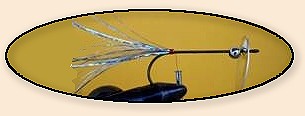
I suggest tying in longer tails for larger
streamers for larger predator fish--Musky,
Pike, and saltwater species. On this streamer
I have cut Silver Holographic Mylar Motion
three hook-shanks for a finished tail of one
and a half hook-shanks.

5. Always wrap the body of the streamer full
with Bodi-Braid, Sparkle Braid, Estaz, or some
other material. Fill the hook-shank from the
hook-bend to behind the bead. The heavier
bead and blade combinations can break a
thread wrapped head of the streamer loose
from the hook-shank even if super-glued.
By placing a body wrap on the hook-shank
of the pattern, you stop the blade and bead
from forcing the entire pattern down the shank.
Silver Holographic Bodi-Works is used on this
pattern.
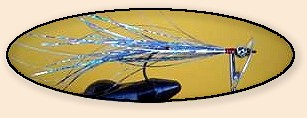
6. This is an optional step to add more
flash or more color to the streamer. In
this streamer, I have added more Silver
Holographic Mylar Motion above and below
the hook-shank to increase the amount of
flash in the streamer. Often I add a
different color like emerald green, bright
red, yellow, olive, etc. to match the sides
of a dominant minnow in the stream. If you
add this optional step remember to keep the
head of the pattern small so the 5/32" bead
will go over the threads of the head of the
streamer or use the 3/16" bead. Put a couple
wraps in the middle of the material then double
it back and finish wrapping it in..
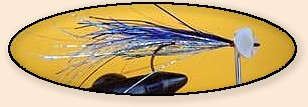
7. Tie in the back of the streamer. Put a
couple wraps in the middle of the material
then double it back and finish wrapping it in.
In this pattern, Blue Metallic Mylar Motion is
used for the back.

8. Tie in the belly of the streamer.
According to the book, What Fish See,
if you use white in a pattern use the
whitest white possible. In this pattern,
White Fluoro Fibre is used for the belly
material. Put a couple wraps in the middle
of the material then double it back and
finish wrapping it in.
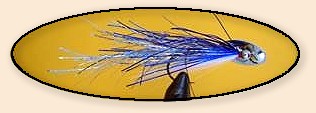
9. Whip-finish the head. I use a long
reach whip-finisher for this job. Make
sure that the thread does not whip in
between the bead and the spinner. Use
a small neat head on the pattern. Make
sure that it is small enough that the
large opening of the bead slides over
the head and leaving plenty of room for
the spinner to spin freely.

10. Super-glue the head of the streamer
and slide the bead over the thread wrappings.
Be careful not to use too much glue and glue
the In-Line Blade to the bead. After applying
the super-glue, I always turn the streamer so
that the eye of the hook is straight up toward
the ceiling until the super-glue dries. This
keeps excess super-glue from running down the
hook-shank to the spinner blade.
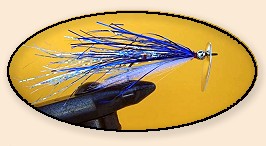
The combinations of materials and colors
are not written in stone when building
Spinner'd Minners. In fact, at my tying
seminars I hand out different materials
and colors to each group or table of tiers
so that when comparing their streamers they
get a good idea of what is possible. I
encourage every tier to be creative when
tying Spinner'd Minners and several other
of my flies.
Suggestions on colors, materials, tactics and equipment
1st) Suggested blade colors for different
colored water recommended by the book,
What Fish See. Silver and
Nickel plated is best in clear or blue
water on sunny days, 24 karat Gold plated
is best in green water, and Fluorescent
Chartreuse and Copper are best in stained
water. However, In-Line Blades are available
in green, blue, hot pink, red and other colors.
2nd) Synthetic materials from Spirit River
materials such as: Hanked Lite-Brite,
Holographic Mylar Motion, Pearlescent
Fly Flash, Metallic Mylar Motion, Mylar
Mirror Flash, Spectra Mylar Motion, Crystal
Splash, Fluoro Fibre, Bodi-Braid, Bodi-Works,
and Estaz for the tail, body, back, and belly
of your patterns are the greatest materials
that I have tested with the "See Best" system
so far. Feathers, fur, and hair are the worst.
3rd) Be creative. One of my favorite patterns
use a 24k gold blade, a 5/32nd gold bead, red
thread, a black flashy tail material, a black
body wrap on the hook shank, a broad gold
stripe above the hook shank, a pearl-white
belly, and a brownish-dark olive back. This
pattern is a killer in the Spring River and
the South Fork of the Spring River because
it imitates the Bleeding Shiner--the most
dominate minnow within these two rivers.
4th) "Cop Colored" Spinner'd Minners (black,
white, and silver) are great producers for
fishing near the surface on bright sunny days
when the water has a little chop due to wind
or current. Trout seem to especially fond
of this combination in a moderate current.
5th) When fishing a Spinner'd Minner, I use
a 7 � foot, 0x tapered leader with a #12 Barrel
Swivel, then about 2-3 foot of 0x-3x for tippet
material. The Barrel Swivel prevents the leader
from twisting and weakening it.
6th) A #1 In-Line Blade Spinner'd Minner can
be easily cast with a 5 weight rod. For #2
use a 7 weight and larger with a Rio Clouser
or some other bass taper fly line.
7th) Surprisingly, controlling the action and
the downstream movements of an In-Line Spinner'd
Minner is easier with a fly rod than a spinning
rig. One example is when fishing across the
current. With a spinning rig the angler must
immediately begin to retrieve the spinner in
order to make it spin. The fly fisher can rely
on the fly line to pull the Spinner'd Minner
and can even "reach cast" putting out more line
and letting the spinner travel down the "current
edge" before retrieving, even when the current
is very moderate. Adjusting the spin of the
blade is quite easy when fishing across the
current. Simply raising and lowering the rod
tip regulates the amount of line catching the
current, thus adjusting the speed of the blade
while the streamer is still moving downstream.
8th) Because Spinner'd Minners are very
light, they do not spin when falling,
instead they wobble and slide on their
way to the bottom. Often times a fish
will take the streamer on the fall, so
be ready for the slightest of strikes.
9th) Spinner'd Minners are light so don't
be in a hurry to start retrieving them.
Give the pattern plenty of time to sink
and get down to the level of the fish.
The Spinner'd Minner may not be seen from
the surface by the angler but have faith.
The flashy spinner blade and material are
reflecting back what ever light is present
at that depth. Remember bass do not have
eye lids so to escape the light they move
deeper and deeper letting the properties
of the water filter out the harsh light.
Also remember that in total darkness the
spinner blade is sending out vibrations
that are sensed by the lateral lines of
fish. The more prominent the lateral line
on a fish the better they sense vibrations.
Basses and browns are fine examples of prominent
lateral lines.
10th) Since knowing the amount of vibrations
created by a Spinner'd Minner is important
to the angler, I now build rods with Tennessee
Sensor handles instead of cork. Cork has a
deadening effect to all vibrations carried
down the rod, where the Tennessee Sensor
handle is a resonator and amplifies the
vibrations. I find that this handle enhances
any type of tight line fly fishing this will
be another article later.

This is a Smallmouth Bass and the Spinner'd
Minner that took him. I caught this Smallie
on the first cast to his lair which was also
the third cast of the day. It was Saturday,
July 31 at noon and 90 degree plus. I did
not take the time to measure this fish because
it was so hot, but the tote lid in the picture
is 33 inches across and the Spinner'd Minner
is 4 inches long. Needless to say the old
rascal fought like a bulldog.
Here is a copy of an email and a Louisiana
Redfish caught by my friend Ralph Bates:
Fox,
When I returned home, I decided to tie a
couple of your Spinner'd Streamer with the
materials I had available. I have attached
a photo of the streamers and the first
redfish I presented the streamer to. I kept
the fish for a neighbor and photographed it
just in case this was the first redfish to
admire the streamer. The second redfish I
presented the streamer to pursued and attacked
the streamer in such a frenzy that I set the
hook to quickly and pulled the streamer away
from him. I only fished the streamer for a
few minutes before going back to a surface
bug because of the extreme shallow water and
structure.
I did return to the streamer later and caught
4 or 5 small speckled trout. The larger trout
will not return from the Gulf for another
month or so.
Ralph L. Bates

Here is another email and a Argentina
Rainbow from Derrick Filkins.
Fox,
Attached are some pictures of fish I
caught on the spinner'd minnows in
Argentina. The rivers were all clear
but they had different backgrounds
above the water and in the water. These
are all rainbows because the streams
we fished where dominantly rainbow rivers.
The first two pictures are from the Rio Grande,
a big wide river that I would say is similar
to the White in color. It may be slightly
darker. The next three pictures are from
the Arroyo Pescado which was gin clear but
very muddy bottom and grassy banks. The last
picture was taken on the Rio Rivadavia which
is gin clear water with heavy green forest on both
sides. The gold spinner with dark olive top
and banana bottom was significantly better
than the silver spinner with black top and white
bottom. That was also the true for the Rio
Grande River and the Arroyo Pescado spring
creek. I caught fish in the Rivadavia and
Pescado on worm scud patterns too. I did that
just do see if they would work down there.
Fishing the spinnered minnows was more fun
and I did not have to wait as long to get bites.
Got to go, more later. Derrick

Fishin' What They See, ~ Fox Statler
|



